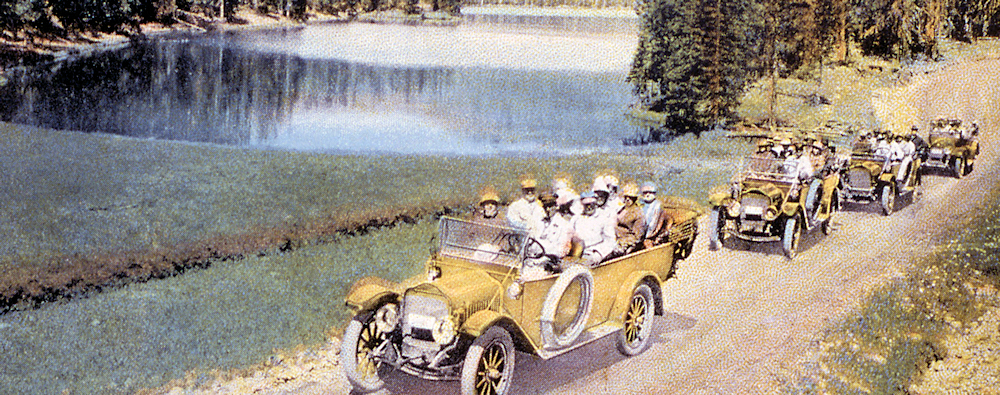Yellowstone, America’s Pleasuring Grounds
This is part one of two parts of the story of Yellowstone’s Early Years.
Why the “Age of the Automobile?” The mass production of automobiles made Yellowstone readily accessible to the average American. And come they did! Thanks to the automobile, visitation to Yellowstone soared between 1916 and 1971. Park visitors expected to see wildlife and geysers, and Yellowstone officials sought to oblige. But with the increase in visitors came attendant challenges, such as managing the wildlife and preserving the Park’s fragile features which came under increasing strain from the presence of humans.
1916 — President Woodrow Wilson signs into existence a new government agency, the National Park Service, forever changing the administration of our national parks. (2: p.64)
1917 – Only two years after the first automobile enters the Park, some 5000 enter Yellowstone during the summer season. (5: p.622)
1918 — With order restored in Yellowstone, the remnants of the Army force which had policed the Park are withdrawn by the government.
1920 — Some 5000 automobiles enter Yellowstone Park.
1922 — Yellowstone celebrates it’s golden anniversary. Dozens of national magazines do feature stories on the Park throughout the year. Ceremonies commemorating the Semi-Centennial year of the establishment of the park are held on July 14, 1922, at the foot of National Park Mountain near the junction of the Gibbon and Firehole rivers where in 1870, in the camp of the famous Washburn-Langford expedition, the “National Park idea” was supposedly born. Mr. C.W. Cook of the Cook-Folsom expedition of 1869 attended in person. Mr. Cornelius Hedges, Jr., and W.A. Hedges planted an evergreen tree to mark the spot where their father stood in 1870 when he proposed making this unequaled region a national park. Public officials and prominent friends of the park are on the program. Superintendent Horace M. Albright makes a short address re-counting the historical development of the park, and reads telegrams from President Warren G. Harding, Hon. Albert B. Fall, Secretary of the Interior, Hon. Stephen T. Mather, Director of the National Park Service, and other high officials. (As recounted in the Hayne’s Guide)
1923 – The Grand Loop Road is named by Harry W. Frantz, a nationally-known writer.
Why the “Age of the Automobile?” The mass production of automobiles made Yellowstone readily accessible to the average American. And come they did! Thanks to the automobile, visitation to Yellowstone soared between 1916 and 1971. Park visitors expected to see wildlife and geysers, and Yellowstone officials sought to oblige. But with the increase in visitors came attendant challenges, such as managing the wildlife and preserving the Park’s fragile features which came under increasing strain from the presence of humans.
1927 — Charles A. Lindbergh barnstorms over Yellowstone Park in September, only months after his historic transatlantic flight. Also, telephone exchanges are installed in the Park. (5: p.269)
1929 — The east boundary and northwest corner of the Park are enlarged, one of two times that the Park has been enlarged (see also 1932).
1930 – The Norris Geyser Basin museum opens as one of the first trailside museums in the park.
1930s — The famous Beartooth Highway is built, allowing automobiles to travel 67 steep, winding miles from Red Lodge, Montana into the Park via the towns of Cooke City and Silver Gate.
1932 – A winter wildlife grazing area near the North Entrance is added to the Park boundaries.
1933 – On February 9, the all time lowest temperature in Yellowstone is recorded: 66 degrees below zero at the Riverside Station.
1947 – Yellowstone Park Service Stations begin operation.
1951 — A travel study by the Wyoming State Highway Department determines that the value of park traffic to the local economy is an estimated $19 million. This led to an awareness of Yellowstone’s recreational business potential. (1: vol. 2, p. 373)
1955 — The State of Wyoming, following the 1951 travel study, seeks to purchase Yellowstone’s concessions. Opposition by Montana and Idaho prevent the passage of this piece of legislation. Also, Mission 66, a massive effort to expand Yellowstone’s roads, trails, visitor facilities and employee facilities, is begun. (1: vol 2, p. 373f)
1950s – CanyonVillage is constructed to keep up with the rising tide of visitors. Also, Park officials, fearing there were too many elk in Yellowstone, reduce the herd during the decade. (1: vol 2, p. 376f)
1958 — The Park stops its policy of stocking park waters for fisherman. (1: vol 2, p. 381)
1959 — A massive earthquake to the west of Yellowstone kills 28 people and sets off such geyser activity in the Park as had never been observed before.
1967 — The Park Service turns to “natural management” in regards to Yellowstone’s wildlife. (5: p.286)
References cited are from Aubrey L. Haines, The Yellowstone Story, Volumes 1 and 2, 1977 editions.
